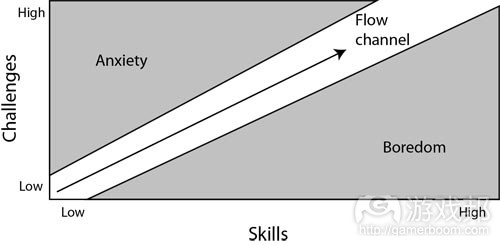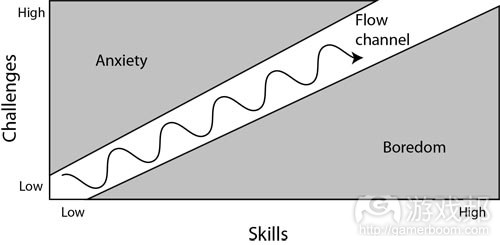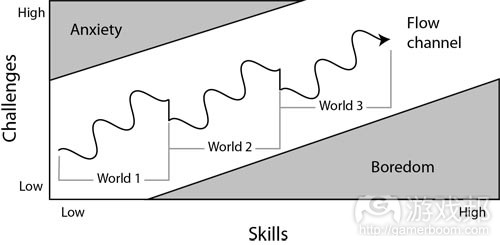游戏设计理论的应用:流状态
作者:Toni Sala
我打算写一系列关于“游戏设计理论及其应用”的文章。游戏通常是靠灵感和直觉设计出来的。这不是什么坏办法,毕竟说到底,游戏设计是个非常讲究创造性的活动。(请点击此处阅读本系列第2、3篇)
然而,有些已经被资深游戏设计师理论化的游戏设计思路,尽管听起来很明显,但在设计自己的游戏时仍然要牢记在心。我想从最有意义和最有效的一个游戏设计概念说起,它就是流状态(Flow Channel)。《推箱子》运用这个概念产生了非常好的游戏体验。尽管通过玩大量游戏你也可以直觉地意识到这个概念,但我第一次看到它是在Jesse Schell的书《The Art of Game Design》中。
什么是流状态?
流状态是使我们专注于某个活动的心理状态。当我们失去流状态时,我们的注意力就会转移到其他活动上。所以显然,我们作为游戏设计师的目标是,让我们的玩家尽可能持久地保持流状态。
这个概念适用于任何人类活动。导致流状态产生的因素各不相同,取决于具体的活动本身。对于游戏,我们要考虑五个因素:挑战vs.技能,焦虑vs.无聊,以及平衡这四个因素的难度,或者叫作难度平衡。
从上图中可以看到所有相关的因素。A是指玩家的状态。理想的状态演变过程是从A1到A4.当处于A1状态时,我们的玩家刚开始玩游戏,还没有掌握游戏的技能。所以低级的挑战(低挑战性)对他来说是合适的,因为此时他的技能水时也比较低。
如果游戏的挑战上升得太慢,玩家就会进入状态A2,也就是无聊期。这时,玩家觉得游戏没那么有意思了,打算放弃了。
另一方面,如果游戏的挑战上升得太快,玩家就会进入状态A3,也就是焦虑期。这时,玩家会觉得游戏太难了(尽管我们可能觉得他的技能水平太低,开玩笑的),仍然可能放弃游戏。
注意:无论玩家觉得游戏太容易或太难,都是游戏设计师的错。玩家总是对的,因为他最懂自己喜欢什么不喜欢什么,他才是他自己的流状态的主人。作为游戏设计师,你的任务是让尽可能多的玩家进入流状态。
焦虑和无聊都会让玩家感到失望,让玩家“失望”是游戏设计师听到的关于自己的游戏的最糟评价。你必须避免玩家对你的游戏失望,无论如何。失望会让玩家离开游戏,而且可能永远也不再回来。
所以,我们的目标是让玩家尽可能留在下图所示的流状态阶段。
然而,Jesse Schell在他的书中告诉我们,这是一个天真的设想。毫无疑问,在上图中,玩家总是留在流状态中。所以他提出另一个更理想的流状态模型:
这种流状态更有意思得多。我们不仅让玩家留在流状态中,而且是给他们提供更好的游戏体验。在上图中,总体游戏难度始终是以合适的节奏上升的,且把玩家留在流状态中。然而,游戏难度以固定的比率波动上升和下降,使玩家在游戏中既觉得舒适又感到满足。
举个例子更好理解:在像《光晕》这样的射击游戏中,一开始你只有很基础的武器,靠这些初级装备和基本的游戏技能就足已放倒你遇到的敌人。但随着游戏进展,你会得到使你变得更强的新武器。根据Schell,这种幼稚的游戏设计方法,会马上提高敌人的实力,以便根据玩家的新状态提供新挑战。
然而,根据第三张图,我们暂时不应该增加敌人的力量。这样,玩家就能享受到短暂的“自己很强大,进步很快”的感觉。然而,这个短暂的时期过后,我们就要提供更多挑战,以免玩家进入无聊期。
所以,在这种波动的挑战中,我们不仅把玩家留在流状态中,还奖励了玩家。如果对玩家来说,玩游戏本身就是一种奖励,那么他就会永远玩下去!这对游戏设计师来说就是最伟大的胜利!
显然,没有说得那么容易。事实上,把玩家留在波动的流状态中是非常非常困难的。不过,我对《推箱子》试了一下,发现结果不太坏。
新的流状态
《推箱子》让我觉得骄傲的是它的谜题设计和总体难度平衡。我花了大量时间调整各个谜题的难度和平衡整体难度曲线。
另外,我还尝试使用本文所说的波动型流状态的概念。这款游戏的当前版本有50个谜题,平分到两个世界中(之后还会推出更多世界)。每个世界都会渐进地引入新的主要设定,使玩家重新整理自己的技能和他目前为止所学到的机制。
显然,第一个谜题会比第二个容易。然而,第22个谜题并不一定比第23个容易。另一方面,当完成一个世界,玩家就会进入另一个,游戏的难度会增加一点点,因为他必须理解新世界的规则。各个世界的25个谜题都使用这种模式。这是波动流状态的不规则版。如果我们进一入察看《推箱子》的波动型流状态,我们会看到下如下图所示的曲线:
所以,一定程度上,各个世界都采用波动型流状态。然而,从一个世界到另一个,在第2个到第4个谜题之间难度曲线会突然增加,这几个谜题是作为新世界的教程,当玩家掌握了就马上提高难度。
这种“不规则流状态”非常适合《推箱子》。玩家很容易就理解和记住这种模式。所以,当谜题引入新机制时,下一个就会稍容易些,为了让掌握了新机制的玩家觉得自己变得更强了。我还随机降低某些谜题的难度,这是为了让玩家觉得“这个谜题难住了,那就跳过去玩下一下,搞不好就过了。”这显然是一条潜意识的信息,玩家不一定会意识到,但管用就行了。最后,这种“更容易的谜题”还让玩家的心态有所放松。在益智游戏中,心态休整是非常重要的,因为如果你觉得累,你可能就会离开游戏,失去对游戏“上瘾”的感觉。
结论
正如你所见,流状态理论在我开发《推箱子》时发挥了重要的指导作用。当我在Schell的书中第一次读到它时,我觉得它是一个显而易见的概念,从这款游戏玩到另一款游戏的过程中我一直在实践它。然而,为了把它正确地运用于游戏设计,你必须深入地研究和理解它。
所以,给你一条重要的提醒:
流状态的概念是非常强大的。无论你做什么游戏,都要使用它。(本文为游戏邦/gamerboom.com编译,拒绝任何不保留版权的转载,如需转载请联系:游戏邦)
Game Design Theory Applied: The Flow Channel
by Toni Sala
I would like to start a series of articles about Theory of Game Design and how I applied (or tried to apply…) it to my projects. Usually games are made by inspiration and intuition. And this is not a bad approach because, at the end of the day, game creation is a deeply creative activity.
However, there are some game design aspects that have been theorized by experienced game designers that, despite sounding quite obvious, it is worth to keep them in mind while working on our games. I would like to start by one of the most interesting and effective concepts of game design: The Flow Channel. Applying this concept to New Sokoban had a very positive impact on the games experience. Despite it being an intuitive aspect of games that you could have learned while playing a lot of games during your live, the first time I red about it was in Jesse Schell’s book The Art of Game Design.
What’s the Flow Channel?
The Flow Channel is the state of mind that makes us to stay focused on an activity. When we loose the flow, we switch to another activity. So obviously our aim as game designers is to keep our players in the flow channel for as long as possible.
This concept applies to any human activity and the factors that make a person stay in the flow are different depending on the activity itself. For games, we are going to consider five factors: Challenges vs. Skills, Anxiety vs. Boredom and the one that balances them all: difficulty or difficulty balance.
Flow Channel States (from “The Art of Game Design” book by Jesse Schell)
On the above picture you can see all the factors in action. “A” is our player. The desired state evolution is from A1 to A4. When in A1, our player has no skills in our game because he has just started playing. So he feels comfortable with a low level of challenge (low game difficulty) because his skills are also low.
If the challenges of the game rise too slow our player will switch to state A2, which is the Boredom realm. Here, the player feels that the game is not interesting an is likely to abandon it.
On the other hand, if the challenges of the game rise too fast our player will switch to A3 state, which is the Anxiety zone. Here, our player will feel that the game is too difficult (despite we may think that his skills are too low… just kidding :p ) and is also likely to go for another activity.
Mental note: if a player feels that your game is too easy or too difficult it is always your fault as game designer. Player is always right, because he is an expert about what he likes and he doesn’t and about his own flow channel. It is your task as game designer to fit the game into the flow channel of the maximum number of potential players.
Both anxiety and boredom drives the player to frustration, and this is the worst word that a game designer can hear about his games. You need to avoid making the player to feel frustrated about your game, no matter what. Frustration makes the player leave the game and probably never coming back.
So, our aim is to make the player stay on flow as showed in the picture below.
Flow Channel Line (from “The Art of Game Design” book by Jesse Schell)
However, Jesse Schell tells us in his book that this is the naive approach. No doubt that in the picture above the player is always in the flow. However, he suggests a better way of being in flow:
Flow Channel Wave (from “The Art of Game Design” book by Jesse Schell)
This is much more interesting. We are not only keeping the player in flow but also offering him a much better game experience. In this last picture, the overall game difficulty is always increasing at a right pace keeping the player in the flow. However, we are slightly decreasing and increasing of difficulty in a fixed rate that makes the player feel both comfortable and pleased with our game.
It is better understood with an example: in a shooting game like Halo you start with a basic arsenal and the enemies you encounter are easy to defeat with your initial arsenal and your basic game skills. However, as you keep playing, you eventually will get a new weapon that will make you more powerful. The naive game design approach, according to Schell, would be to immediately increase the power of the enemies to offer new challenges according to the new state of the player.
However, according to the waved Flow Channel picture we should not increase the power of the enemies for a while. In doing so, the player will enjoy a short period of time feeling powerful and the feeling of progress will also be reinforced. However, after a while, we need to offer more challenges to the player to avoid him to enter the Boredom realm.
So, with the waved Flow Channel we are keeping the player in flow and, in addition, we are rewarding him simply for playing. And if just playing our game is rewarding for the player, he will keep playing for the eternity! Epic win for the game designer! :p
Obviously it is not that easy. Actually, keeping the player in a Waved Flow Channel is very very difficult. However, I have tried it for New Sokoban. And it was not that bad.
New Sokoban Flow Channel
If I’m proud of one thing about New Sokoban, it is the puzzle design and the overall difficulty balance. You can read a little bit more about this on this old post. I have spent tons of hours fixing the difficulty of each puzzle and balancing the overall difficulty curve.
And I also tried to apply the Waved Flow Channel concepts described in this article. The current version of the game has 50 puzzles organized into two worlds (two more worlds are planned). Every world introduces a new main feature that makes the player rearrange all the skills and mechanics that he has learned so far.
Obviously, the very first puzzle is much easier than the last one. However, for example, the puzzle number 22 is not necessary easier than the number 23. On the other hand, when a world is completed and the player moves to the next one, the difficulty is decreased a little bit because he needs to understand the new world rules. I repeat this pattern along the 25 puzzles of each world and also for the worlds. It is a kind of fractal pattern for the difficulty curve. If we zoom into the Waved Channel Flow for New Sokoban we would see something like the picture below:
Fractal Flow Channel, extended from Waved Flow Channel
So, in some sense, I follow the Waved Flow Channel in each world. However, from world to world the difficulty curve is suddenly decreased during 2-4 puzzles that serve as tutorial for the new world and then immediately increased when the player gets it.
This kind of “Fractal Flow Channel” has worked very well for New Sokoban. The player easily catches and interiorizes it. So, when a puzzle introduces a new mechanic, the next one is slightly easier, just to make the player “feel the power” that the new mastered game mechanic has given to him. I also decrease the difficulty of a given puzzle arbitrarily, just to say to the player: “Hey! If you get stuck in a puzzle skip it. Maybe you will be able to solve the next one.” It is obviously a subliminal message, the player is not necessarily aware of that, but it just works fine. Finally, this kind of “easier-puzzles” also make the players mind to take a rest. Mind resting in puzzle games is important because if you feel tired you will probably leave this game session and loose the feeling of being “addicted” to the game.
Conclusion
As you can see, the Flow Channel theory has been very important for me and for the development of New Sokoban. When I first red about it in Schell’s book I thought that it was an obvious concept that I had been practicing for my whole live while playing games from others. However, it is important to think deeply about it and understand it fully to be able to apply it correctly on your games.
So, here you have a very useful mental note:
Mental note: The Flow Channel concept is a very powerful one. Try to use it in all of your games.(source:gamasutra)












































 闽公网安备35020302001549号
闽公网安备35020302001549号